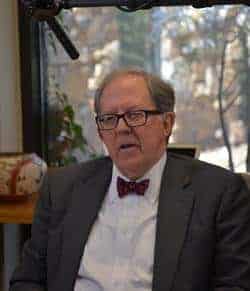
06 Oct COWBOY BOB AND BLACK MAGIC
COWBOY BOB AND BLACK MAGIC:
The Story of the Dynamic Death Squad Duo
(PART I OF II)
Recently I learned of the death of former Oklahoma City forensic chemist Joyce Gilchrist. After much reflection I have decided to write about Ms. Gilchrist and former Oklahoma County District Attorney Bob Macy. I am going to examine the relationship between the prosecutor and the chemist and in particular two cases which I think reflects the impact that this duo had on the Oklahoma Justice System. The two cases I’m going to highlight both include men that were prosecuted by Macy and sent to death row, only to be exonerated years later, as a result of deplorable investigative tactics and junk science.
COWBOY BOB
Robert H. “Cowboy Bob” Macy was sworn into office in 1980. Within the first two weeks of his administration a triple homicide that occurred at a south side motel, came across his desk. Macy targeted a paunchy poker player named Clifford Henry Bowen as the murderer.
Although 12 alibi witnesses testified that Bowen was 300 miles away at a rodeo in Tyler, Texas, Macy was convinced he was their guy. Macy presented circumstantial evidence, and witnesses (one of whom was hypnotized to help her remember better, a fact not shared with the defense) that he claimed proved that Bowen was the killer. In closing argument, Macy speculated that Bowen had flown in and out of Oklahoma City by private jet in order to pull off the murders.
The jury returned a verdict of guilty and recommended 3 sentences of death. Within five years, a federal judge overturned the convictions. Among the reasons stated by the court was that Macy and his team did not share information critical to the defense. Macy would claim that the courts cost him the trial over a technicality.
It would not be the last time Cowboy Bob asked for and got the death penalty. It would also not be the last time he would be criticized by an appellate court, or watch a man he prosecuted be exonerated from Death Row.
BLACK MAGIC
Joyce “Black Magic” Gilchrist came to the Oklahoma City Police Department as a forensic chemist in 1985. Although her gifts in the field of chemistry itself may have been questionable (she received a grade of D in general chemistry at OU, and she earned C and D grades in chemistry courses like general physics and quantitative analysis at UCO), she had a natural gift for testifying. This gift, more than her actual job skills, quickly gained her the attention of the Oklahoma County District Attorney’s Office, and its pragmatic leader Cowboy Bob Macy.
In a 2011 interview, Macy said of Gilchrist, “To be honest I liked Joyce. She was a professional. When she came into a courtroom, she would wear a business suit and makeup, but nothing flashy. She was so…good. The reason the defense attorneys didn’t like her was because she was better prepared than they were. She would make a better presentation to a jury. She probably did win more than her share of the arguments because she was prepared.”
She gained the moniker “Black Magic” because of her ability to match physical evidence that other well known and accomplished forensic examiners could not. Nine years after she started as a forensic chemist she was promoted to supervisor, and over the course of her 21 year career she testified in over 3,000 criminal cases, leading to 23 people being sentenced to death, 11 of whom have been executed.
I’m going to examine two cases in which both Mr. Macy and Ms. Gilchrist played a major role in. The first case is that of Robert Lee Miller Jr. Miller was sentenced to death in 1988 only to be exonerated ten years later. The second case is that of Curtis Edward McCarty, he was sentenced to death in 1986 and exonerated in 2007.
ROBERT LEE MILLER JR.
On September 3rd, 1986, 83 year-old widow, Anna Fowler was found dead in her bed. She had been raped and murdered. Four months later, Zelma Cutler, a 92 year-old widow who lived in a corner house in the same neighborhood, met the same cruel fate. Semen, collected and tested, showed that both rapes were committed by someone with type-A blood, and three hairs found on sheets covering Cutler’s body were said to have “negroid” characteristics.
Many signs pointed to it being the same perpetrator that committed the crimes. Both women lived in the same neighborhood, both lived alone, no property was taken from either residence, and both women were suffocated under the weight of their attacker.
A task force was formed which included 12 of Oklahoma City’s finest. Detectives soon created a list of suspects: 173 black men, all of whom were interrogated. From this group, twenty-three suspects gave blood. Robert Miller was one of the suspected black men that gave blood which tested as A-positive.
On February 23, 1987, detectives visited Miller at home and asked for his assistance in solving the murders. A regular drug user, it is believed that Miller was under the influence of PCP, a powerful hallucinatory drug. Nonetheless, he wanted to help so he accompanied the detectives to the station, and what happened next is unbelievable, but true.
THE INTERROGATION
The interrogation was led by Detective Jerry Flowers and his partner David Schupe, who was operating the hidden video camera. Soon into the interrogation Miller said, “I’ve got these powers…I can see through the killer’s eyes.” According to one account, “the next twelve hours were a numbing drone of hallucination, interrogation, exorcism, revival, and nonsense.”
Near the beginning of the taped interrogation, when Miller complains of being disturbed by demons, spirits, and spells, Detective Bob Woods (also in the room by this time) helpfully yells out, “Satan, get back in the corner!” To prevent future further interruption by the devil and his minions, Detective Woods gave Miller a pocket Bible. Then in what can only be described as a particularly clever faith-based initiative, Miller and Detectives Woods and Flowers each solemnly placed a hand on the Bible, a collective embrace which lasted for several hours.
Over the course of the ensuing hours, Detectives quoted Bible verses, prayed, and even called upon God himself to intervene and help Miller remember his dreams: “Oh Lord, give this man the power to recall the vision,” beseeched one detective. Although Miller continued to proclaim his personal innocence, at one point Miller prayed, “My Father, Lord in Heaven, let them know that I did not do this”, the detectives remained vigilant.
Prosecutors would claim that Miller’s recount of his vision was equal to a full confession. Macy told Miller’s jury, “He knew detail after detail. Details only the killer would know.” Assistant District Attorney (now Oklahoma County District Judge) Ray Elliot would later argue in court that Miller knew some “forty-five facts” that were known only to the killer.
False confessions occur more often than the general pubic thinks, and can come as a result of questionable police interrogation techniques, but few things are more powerful to a jury than a confession, and arguing that a confession was false is difficult to explain to the general public. I want to examine just a small portion of the interrogation which both Macy and Elliot claimed resulted in Miller disclosing facts known only to the killer.
THE UNDERWEAR
At trial Cowboy Bob gave a dramatic presentation regarding an underwear band that was dropped at one of the murder scenes. Fruit of the Loom, the same as that worn by Miller. Early in the interrogation when Miller was asked repeatedly what the killer left at the scene, he guessed articles of clothing, tools, until at last he hit on the underwear. The following is what occurred when the detectives locked in on that detail:
Flowers: When the man got through doing what he was doing to the woman, think really hard ‘cause this is really important. Did he leave anything with her?
Miller: He might have.
Flowers: What would he have left, look into your dreams and tell me what he would have left. Did he leave any articles?
Miller: Yeah, something.
Flowers: What did he leave?
Miller: ‘Cause he was in a hurry.
(At this point Miller goes into a verbal wander, and the officers summon a higher power.)
Flowers: Jesus help this man to recall…What would he have left there with that woman?
Woods: Help this man remember, Jesus!
Miller: He left something.
Flowers: Was is some type of article or what kind of article wast it, a rock, was it some type of object, was it a clothing item?
Miller: Maybe.
Flowers: Maybe what?
Miller: ‘Cause I have some clothes missing, too, at 29th Street.
Flowers: What did-look at me, Robert. Let’s go back in your dream. Let’s go back in your dream. What did this person leave inside that house, that maybe it was stolen from you…? What was left in that house?
Miller: Might have been something of my hair. I don’t know.
(At this point the detectives become frustrated and return to the subject of clothing. They ask Miller to close his eyes and imagine what kind of clothes he would have left.)
Miller: Maybe a shoe or something? I don’t know. I have to check my shoes again.
The Detectives offer their assistance, directing Miller away from answers like hair, and knife, and continue to direct him to articles of clothing.
Flowers: Look at this person’s body, what’s this person missing off his body, does he have his shirt on, what is he missing?
Miller: It might have been the shirt.
Flowers: What is he missing, look at the person.
Miller: She tore something off of him…She tore some of the clothes. Probably the knife.
Flowers: Does he have shoes on?
Miller: I don’t…he might have left one.
Flowers: Does he have pants on?
Miller: Uh-huh.
Flowers: Look at the person he’s fixing to leave, but he realizes he’s leaving something, what is it he’s leaving?
Miller: It might have been underwear or something, he left something in the house.
As this line of questioning continues Miller erratically moves back and forth between underwear and then gloves. Later in the interrogation Flowers tells Miller that he had mentioned that the killer left underwear. Miller responds that he can’t remember saying that, and eventually tells the officers that the killer “forgot something, either his underwear or a glove…”
The rest of the interrogation is not any better. Filled with inconsistencies, the only thing that is apparent is that Robert Miller is just as likely to be the killer as he is clairvoyant. By the end of the interrogation, Miller had stated 112 inconstancies, and told the detectives that he was the Lone Ranger and an Indian Warrior and that his family had visionary powers.
However, Macy and Elliot claimed that Miller was confessing, how could he know so many details about the crime? How could Miller know what the killer was thinking, if he wasn’t the killer himself? Cowboy Bob’s Dynamic-Death-Squad had another ace up their sleeve, Black Magic.
SCIENCE?
In addition to the “confession”, Macy emphasized the results of hair and semen tests conducted by Gilchrist. According to Gilchrist, lab results indicated that semen from the crime scene came from a person with type-A blood, which did not match the victim. She said Miller matched this blood type and had other markers in common with the evidence, so she could not exclude him as a suspect. Gilchrist also tested blood and saliva samples from the same crime scene and found different blood markers, inconsistent with Miller’s sample. She justified this result by stating that the sample was mixed and could have included markers from the victim’s blood. Based upon this same report the state also eliminated Ronald Lott, another primary suspect in the investigation.
Gilchrist also testified that hair samples found at the scene had “negroid” characteristics, but she couldn’t identify an individual. This was bad for Miller since he was the guy in the room that the jury was staring at, and he happened to be black.
Amazingly Gilchrist also testified that animal hairs collected at the scene had similar characteristics to hairs from a neighborhood dog that Miller was known to care for. When asked about DNA testing she explained that it was not performed because Oklahoma courts did not recognize DNA testing at that time.
The jury found Robert Miller guilty on all counts and he was later sentenced to death for the two murders. For the two rapes, he was sentenced to 287 years and 392 years. He was sentenced to 20 years for each burglary charge and 10 years for an attempted burglary.
From the moment Miller was found guilty there were many that thought something had gone terribly wrong here. Oklahoma Indigent Defense Chief Bob Ravitz began looking for some way to have the DNA from the crime scene tested, but at that time in Oklahoma indigent persons were not entitled to such testing unless they could pay for it themselves. The testing was eventually ordered by Ravitz, who was convinced of Miller’s innocence, and the results excluded Miller.
On February 24, 1995-eight years and one day from the date of Miller’s so-called confession-the Oklahoma Court of Criminal Appeals granted an application filed jointly by the prosecution and the defense to reverse Miller’s convictions based upon newly discovered DNA testing. If you think that this meant Miller would walk out into the sunshine for the first time in 8 years a free man, you forget on unmistakable fact. Cowboy Bob Macy and his Dynamic Death Squad do not make mistakes, much less admit them. Robert Miller, cleared by DNA evidence would spend another 3 years in jail.
NOW HE’S AN ACCOMPLICE
The DNA evidence did not exclude Ronald Lott. Remember he was the same Ronald Lott that was excluded by the analysis of Joyce Gilchrist. The State switched their entire theory of the case. Confronted with DNA evidence linking Lott to the crime scene, the State hypothesized that both Lott and Miller, who had never met, collaborated on the murder. Lott’s DNA meant he was responsible for the rape, but Miller’s confession showed that he was in on the murders.
Famed attorney Barry Scheck, most notably of the Innocence Project would become involved in the fight to win Miller his freedom. In his book entitled, Actual Innocence, he recalls a disturbing chance encounter while at the Timothy McVeigh trial in Denver, Colorado. A man in line of Scheck turned to him and offered his hand.
“Ray Elliot,” he said.
“You’re the same Ray Elliot who still wants to try our client Robert Miller for murder?” asked Barry.
“The same one,” said Elliot.
On that morning, Robert Miller had been on death row in Oklahoma for nine years. For six of those years, the state had DNA tests proving that he wasn’t the killer. Yet he had languished. The whole plot of Miller’s life stood between the two men in their pinstripe suits, shuffling toward metal detectors.
“I just don’t understand what’s taking so long,” said Barry. The DNA shows who the real murderer is. And it’s not Robert Miller.”
“All the DNA proves is that there were two killers, not just Robert Miller,” said Elliot. “All we know from the DNA is that he was not the donor of the semen. We know from Robert’s own statement that he was there. He knew things that only the killer would have known.”
“You know that he made one-hundred and thirty-three wrong guesses in that videotape,” said Barry.
Elliot smiled.
“His own words put him at the scene of the murder. Don’t worry about it, Barry. We’re going to needle your client.”
Needle our client? Barry was bewildered.
“I am sorry,” Barry said. “I don’t know what you mean.”
“You know. Lethal injection, the needle,” explained Elliot. “We’re going to needle Robert.”
Before I go on and finish the story I have to stop for just a moment and editorialize. This is a clear depiction, a great example of the sickening mindset of Cowboy Bob’s administration. How could any attorney or even lay person convince themselves let alone others that it was so impossible that they could make a mistake, only to double-down and spew such terrible vitriolic rhetoric? Did I mention that Ray Elliot is currently a District Judge? He was elected to the position of District Judge in Oklahoma County in 1998 and currently serves as the trial judge in the Criminal Division of the District Court.
Anyway, so things continued to be at a standstill and Miller languished. Then one day, Oklahoma City Attorney Garvin Issacs, picked up the phone spoke with Sheck. By the end of their conversation, Isaacs had agreed to look into the Miller case and devoted the next eight months trying to secure his freedom. For this he was paid $1.00 for his services.
Garvin Isaacs is personally a hero of mine, and unsurprisingly he was able to move Miller’s case through the court system with the dogged determination he is so well known for. On January 22, 1998 Robert Lee Miller Jr. was fully exonerated and released from custody. Robert spent seven years on death row and almost ten years wrongfully imprisoned.
Cowboy Bob Macy never acknowledged Miller’s innocence. In a February 2001 New York Times article, Public Lives: A Proud and Unwavering Believer in the Death Penalty, Macy stated that he still believed that Miller was an accomplice.
In Part II we will examine the case of Curtis Edward McCarty and the legacy of the Cowboy Bob’s Dynamic Death Squad. This will include those that still remain as remnants from a lost and disgraced administration, notably Richard Glossip.








No Comments